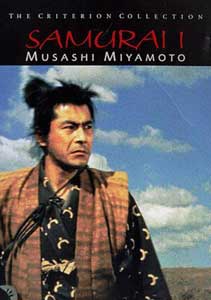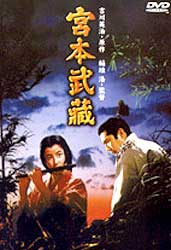 Early in the 1600s there lived a man named Musashi Miyamoto -- Takezo in his youth -- who had the audacity to rise from his rude birth to master of Zen & swordsmanship.
Early in the 1600s there lived a man named Musashi Miyamoto -- Takezo in his youth -- who had the audacity to rise from his rude birth to master of Zen & swordsmanship.
He became a painter, sculptor, sumi-e artist, calligrapher, & author of The Book of Five Rings, a classic work on martial philosophy & a best seller throughout the world centuries later.
And he did it all without compromising his rude origins, as we would remain forever a man adverse to bathing, with little interest in social niceties of any sort.
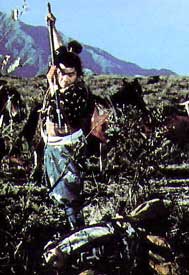 Musashi fascinated director Hiroshi Inagaki for a good portion of the filmmaker's career. His first Musashi trilogy (1940) in black & white, starring Chiezo Kataoka in the title role, was only part of what would eventually build to twelve films inclusive of remakes, focused on the life of Musashi, four of the twelve focusing more on Musashi's nemesis Sasaki Kojiro (1950-51, 1967). Musashi fascinated director Hiroshi Inagaki for a good portion of the filmmaker's career. His first Musashi trilogy (1940) in black & white, starring Chiezo Kataoka in the title role, was only part of what would eventually build to twelve films inclusive of remakes, focused on the life of Musashi, four of the twelve focusing more on Musashi's nemesis Sasaki Kojiro (1950-51, 1967).
Inagaki remade his original black & white trilogy in full color (1954-55) starring Toshiro Mifune. This received the Academy Award for Best Foreign Film, though the Academy saw only a confused abbreviated version.
The director's source material was not the historical Musashi who never bathed, but the fictionalized improved figure of Eiji Yoshikawa's novel Musashi Miyamoto first serialized in Asahi Shimbun from 1935 to 1939.
Such serials were a commonplace of Japanese periodicals & newspapers, with several becoming chambara or samurai film classics as well.
But the most influential of all such serials has got to be Musashi Miyamoto which not only gave the world a new Musashi to admire, all obliterating memory of the unbathed & uncouth student of Zen whose military tactics amounted to trickery without honor. And this revamped Musashi has even come to be regarded as an embodiment of Japanese spirit, though the historical Musashi would probably laugh at the irony of that.
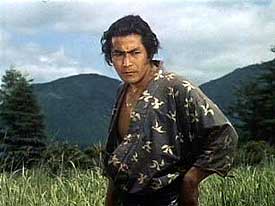 Hiroshi Inagaki's adaptation became known in the west as Samurai Trilogy. In the opening of part one, Musashi Miyamoto; aka, Samurai 1; aka, The Legend of Musashi (Miyamoto Musashi, Toho, 1954), it is the year 1600 & the battle of Sekigahara is pending.
Hiroshi Inagaki's adaptation became known in the west as Samurai Trilogy. In the opening of part one, Musashi Miyamoto; aka, Samurai 1; aka, The Legend of Musashi (Miyamoto Musashi, Toho, 1954), it is the year 1600 & the battle of Sekigahara is pending.
Takezo (Toshiro Mifune) believes the battle will provide opportunity for even a farmer to become a samurai. He convinces his friend Matahachi (Rentaro Mikuni) to follow him in this dream.
Matahachi, unlike orphaned Takezo, has his mother Osugi & his betrothed Otsu to consider. But he is not a man who thinks for himself, so he follows Takezo.
They are alas on the losing side of the battle. Matahachi is slightly wounded. Takezo carries him across a hostile countryside, avoiding shogunate soldiers who are busily exterminating surviving stragglers.
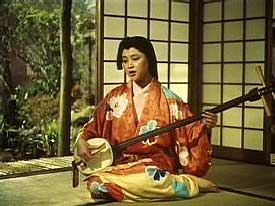 They find sanctuary in a farmhouse where a brigand's widow Oko (Mitsuko Mito) & daughter Akemi (Mariko Osho) live alone. They find sanctuary in a farmhouse where a brigand's widow Oko (Mitsuko Mito) & daughter Akemi (Mariko Osho) live alone.
Oko & Akemi are similar to the women in Kaneto Shindo's Onibaba (1965). They survive by robbing dead samurai of their armor & weapons & selling them. This puts them at odds with bandits who don't want the competition. The women need a man like Takezo or Matahachi for protection.
It is here for the first time that Takezo rejects the advances of women, a symbolic gesture repeated ad nauseum in the trilogy as an indication of strength. When the widow attempts a seduction (after Takezo has already rejected the daughter's flirtations), he is so repulsed that he runs off to a river to purify himself. It's rather venal & misognyist symbolism indeed.
In director Yasuo Kohata's version Musashi Miyamoto (Miyamoto Musashi, 1954), which gives Rentaro Mikuni the role of Musashi, the interpretation is very different. Takezo is a rapist rather than an appalled victim of women's lust, & he even has a doomed bastard son as a result of his assault.
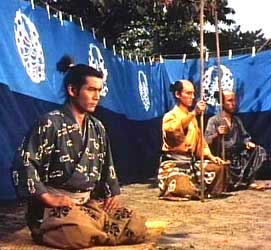 Matahachi, forever the weak one, is the widow's second choice. He lacks even the strength of will to return to his home village & mother. Matahachi, forever the weak one, is the widow's second choice. He lacks even the strength of will to return to his home village & mother.
Takezo returns with the intent of telling Mother Osugi that her son is alive but won't be coming home. His behavior is so wild, however, that he is mistaken for a brigand & eventually kills someone on sacred ground.
He becomes a hunted man lurking in the swamps & woods, living like an animal. This reimagined part of Musashi's "biography" puts all of the historical Musashi's more alarming traits exclusively at the beginning of his career, traits he will overcome.
Priest Takuan (Kuroemon Onoe), with help from Onoe (Kaoru Yachigusa), sets out to capture the wild Takezo, using various wiles. Eventually he's tricked into entering a castle tower where he is locked up for three years with all the books Priest Takuan believes will transform Takezo's wildness into something for the betterment of humanity, or for himself at least.
Otsu, though originally betrothed to unfaithful Matahachi (unbelievably since she has nothing of a farming disposition & is ridiculously frail), has fallen for Takezo & waits for him the entire three years.
But when released, he is indeed a changed man, given a new name, Musashi Miyamoto. His interest in Otsu has waned, presuming it was ever strong. Though guilt-ridden about her fate, he again shows that he has the singular power to avoid women, whether he finds them icky or just has better stuff to do.
Off into the sunset he goes, upon his musha-shugyo (warrior pilgrimage), leaving heart-broken Otsu whining obnoxiously on the bridge.
copyright © by Paghat the Ratgirl
|
